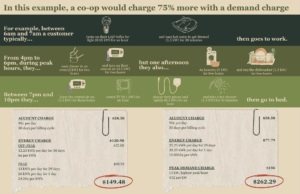Many South Carolina residents receive their electricity from investor-owned utilities like Dominion Energy and Duke Energy, or from government-owned utilities like Santee Cooper. Others are served by a member-owned electric cooperative, also known as a “co-op.” These co-ops were created in the 1930s to bring electricity to rural areas, and today, 19 of them serve homes across the state.
Residential electricity bills typically include two parts: an account (or service) charge, which is a flat daily or monthly fee for providing electricity, and an energy charge, which covers the actual electricity used.
Recently, some electric co-ops have also added a peak demand fee. This fee is based on the single highest amount of electricity you use during peak hours. Peak hours are when electricity demand is highest, which is often 6:00-9:00 AM from November to March and 3:00-6:00 PM from April to October.
Peak energy demand charges are designed to reduce usage when the utility grid is most stressed and cost-intensive to shift some of the usage to lower-demand hours. However, in practice, peak demand charges can be burdensome for customers, especially those who may be unaware of these changes. Sudden spikes in electric bills can be devastating for families that are already struggling to keep the lights on. It can also be very difficult for people to reorganize their lives to avoid using major appliances during peak hours.
In this new structure, a single-hour average of usage during just one day out of the month can now make up a larger fraction of their electrical bill, making it seem less worthwhile to continue to try to save energy for the rest of the month.
While it is good to incentivize customers to reduce usage, especially during times of peak demand, it is important to make sure the mechanisms used are clear to the customer and do not risk disincentivizing energy conservation.
LEARN MORE.
Scroll through our StoryMap to learn more about how this works, who it is impacting and what it means for our electricity usage as a state.
In this example, an energy customer would see a 75% increase in their bill, largely due to the afternoon they used more than their typical amount of energy to complete household chores.

